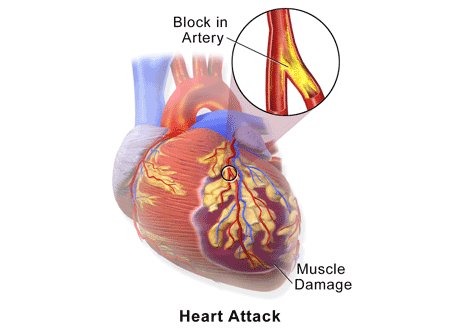Best Heart Attack Treatment in Delhi
The most common warning sign of a heart attack
is chest pain. Other symptoms may include lightheadedness, nausea, and shortness of breath. Some
people may not notice any signs of a heart attack at all.
This article will look at the causes, symptoms, and risk factors of a heart attack, as well as
how one is diagnosed and treated.
What exactly is a heart attack?
A heart attack occurs when blood flow to the heart is interrupted or blocked. If there is
insufficient oxygen-rich blood flowing to the heart, it can cause damage to the affected area.. As
a result, the heart muscle starts to deteriorate.
You are more likely to develop heart failure and other serious complications if your heart does
not receive the blood and oxygen it needs to function properly.
A heart attack is a life-threatening medical emergency. The sooner you get medical help to restore
normal blood flow to your heart, the better your chances of recovery.

Symptoms of a heart attack
The following symptoms may be caused by a heart attack:
- Chest discomfort or pain
- Shortness of breath arm, shoulder, or neck pain nausea sweating lightheadedness or dizziness fatigue upper body pain
- Breathing difficulties
Causes of a heart attack
The leading cause of heart attacks is coronary heart disease.. This is the formation of plaque in the arteries that supply blood to the heart. The general buildup of plaque in the arteries is known as atherosclerosis.
Heart attacks are classified into two types.
- Type I heart attacks occur when plaque on the inner wall of the artery ruptures, allowing cholesterol and other substances to enter the bloodstream.This can then cause a blood clot to form and block the artery.
- Type II heart attacks occur when the heart does not receive enough oxygen-rich blood, but an artery is not completely blocked
The following factors can also contribute to heart attacks:
- Blood vessel rupture
- Drug abuse and blood vessel spasms
- A lack of oxygen in the blood is referred to as hypoxia.
Risk factors for a heart attack
A heart attack can be brought on by a variety of factors. Some factors, such as age and family history, are unchangeable. Modifiable risk factors, on the other hand, can be altered.
You can help control modifiable risk factors such as:
- Smoking
- Obesity due to high cholesterol
- Lack of physical activity, high levels of stress, diabetes or pre-diabetes
- Consuming a high-fat diet that is high in trans and saturated fats
- Excessive booze consumption
- Obstructive sleep apnea
How is a heart attack identified?
A heart attack is typically diagnosed after a physical exam and review of your medical history. Your doctor will most likely perform an electrocardiogram (ECG) to assess the electrical activity of your heart.
- An echocardiogram, which uses sound waves to create an image of the heart's chambers and valves, can reveal how blood flows through the heart and which parts, if any, of the heart have been damaged.
- A cardiac catheterization may also be ordered by your doctor. This is a probe that is inserted into blood vessels via a flexible tube known as a catheter. It allows your doctor to see areas of your heart where plaque may have accumulated. They can also inject dye into your arteries, order an X-ray, and examine any blockages.
- Your healthcare team will most likely take a blood sample or run other tests to see if there is evidence of heart muscle damage.
Treatments:
If you've had a heart attack, your doctor may advise you to undergo a procedure (surgery or nonsurgical). These procedures can alleviate pain and help prevent another heart attack.
How is a heart attack identified?
- Stent. A stent is a wire mesh tube that surgeons insert into the artery after angioplasty to keep it open.
- Angioplasty. An angioplasty is a procedure that uses a balloon to open a blocked artery or removes plaque buildup. It's worth noting that angioplasty is rarely used alone by doctors anymore.
- Cardiovascular bypass surgery Your doctor will reroute the blood around the blockage during bypass surgery.
- Heart valve replacement. Surgeons repair or replace leaky valves in valve repair or replacement surgery to help the heart pump.
- Pacemaker. A pacemaker is an implantable medical device that is placed beneath the skin. It can assist your heart in maintaining a normal rhythm.
- Transplantation of the heart In cases where a heart attack causes permanent tissue death in the majority of the heart, surgeons may recommend a heart transplant.
To treat your heart attack, your doctor may also prescribe the following medications:
- Aspirin and other clot-busting medications antiplatelet and anticoagulants, also known as blood thinners pain relievers
- Blood pressure medication nitroglycerin
- Beta-blockers

